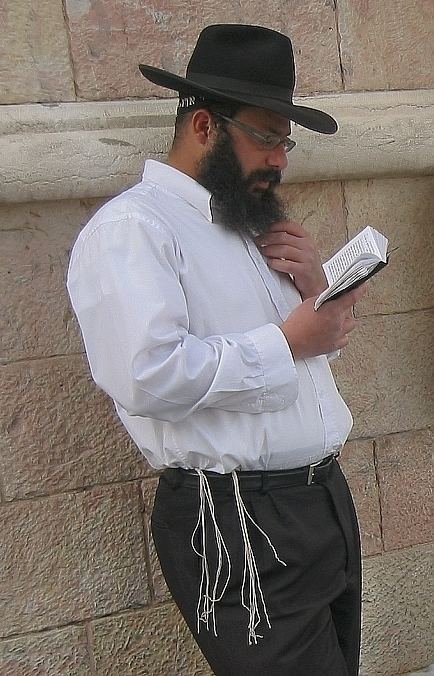 | ||
Jewish religious clothing has been influenced by Biblical commandments, modesty requirements and the contemporary style of clothing worn in many societies in which the Jews have lived. In Judaism, clothes are also a vehicle for religious ritual. Many Jewish men wore turbans, tunics, cloaks, and sandals.
Contents
Tallit, tzitzit, and tallit katan
The tallit is a Jewish prayer shawl worn while reciting morning prayers as well as in the synagogue on Sabbath and holidays. The tallit has special twined and knotted fringes known as tzitzit attached to its four corners. It is sometimes referred to as arba kanfot (lit. "four corners") although the term is more common for a tallit katan, an undergarment with tzitzit. According to the biblical commandment, a blue thread known as tekhelet is supposed to be included in the tzitzit. Tzitzit are fringes or tassels worn by observant Jews on the corners of four-cornered garments, including the tallit (prayer shawl). Since they are considered by Orthodox tradition to be a time-bound commandment, they are worn only by men; Conservative Judaism regards women as exempt from wearing tzitzit, not as prohibited. Jewish men are buried in a tallit as part of the tachrichim (burial garments).
Kippah
A kippah or yarmulke (also called a kappel or "skull cap") is a thin, slightly-rounded skullcap traditionally worn at all times by Orthodox Jewish men, and sometimes by both men and women in Conservative and Reform communities. Its use is associated with demonstrating respect and reverence for God.
Women's hair coverings
Orthodox Jewish women wear a scarf (tichel), a snood, a hat, a beret, or - sometimes - a wig (sheitel) in order to conform with the requirement of Jewish religious law that married women cover their hair.
There are non-canonical rabbinical writings on hair covering in relation to tzniut (meaning "modesty"), such as: Shulchan Aruch, Rabbi Jacob ben Asher's Stone of Help 115, 4; Orach Chayim 75,2; Even Ha'ezer 21, 2 4.
Kittel
A kittel (Yiddish: קיטל) is a white knee-length cotton robe worn by Jewish prayer leaders and some Orthodox Jews on the High Holidays. In some families, the head of the household wears a kittel at the Passover seder. In some circles it is customary for the groom at a Jewish wedding to wear a kittel under the wedding canopy.
